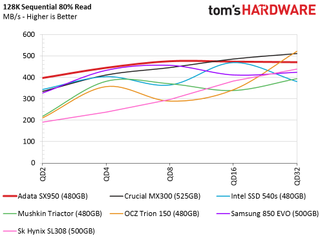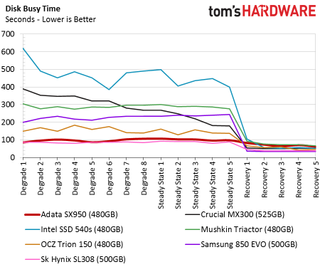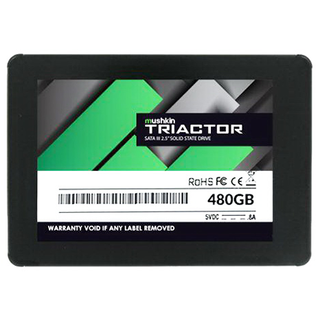Adata XPG SX950 SSD Review
Why you can trust Tom's Hardware
Comparisons & Benchmarks
Comparison Products
The SATA SSD market hasn't been very exciting lately. Samsung released the 850 EVO in a wide range of capacities that scale all the way up to 4TB. In the interim, only a very few SSDs have matched the EVO's performance, features, and pricing. The Sk Hynix SL308, and soon the SC308, are the most notable. The Adata XPG SX950 looks to join those ranks with a combination of 3D NAND and firmware tuned to deliver a high-performance user experience.
We've included the notable SSDs in our review and added the Crucial MX300, also with Micron 3D NAND, and the Intel SSD 540s. The Mushkin Triactor and OCZ Trion 150 fill in the gaps, but, like the MX300 and 540s, don't deliver on the same level as the product from South Korea.
Sequential Read Performance
To read about our storage tests in-depth, please check out How We Test HDDs And SSDs. We cover four-corner testing on page six of our How We Test guide.


All of the devices deliver exceptional sequential read performance. This is the easiest workload for storage devices. Gamers looking for fast load times can gauge performance with this chart. The differences between products are minimal. That's why many people say SATA SSDs all perform about the same.
Sequential Write Performance


You can see the difference if you challenge the SSDs with more complex workloads. The Adata XPG SX950 uses MLC flash, so we don't have to worry about a large sequential write drop-off like TLC-based products. We confirmed the steady performance with HD Tune Pro by applying a sequential write workload across the entire LBA range.
Random Read Performance



Random workloads expose the most performance variation. Random read performance is one of the most important aspects of the four-corner measurements because it directly relates to the user experience. Flash is so fast that the queue depth rarely reaches more than three or four, but your PC contently reads and writes small random files to log data and launch applications. We like to see queue depth (QD) 1 random read performance north of 10,000 IOPS, but it's difficult to achieve. Even new NVMe SSDs have a difficult time reaching that high mark. The SX950 doesn't reach it either, but it does perform well for a mainstream SSD.
Random Write Performance



The Adata XPG SX950 delivered really odd random write performance during our automated test. We think the plastic case traps heat and promotes thermal throttling during extended heavy workloads. A metal case would help dissipate the heat instead of serving as insulation.
80% Mixed Sequential Workload
We describe our mixed workload testing in detail here and describe our steady state tests here.

The XPG SX950's mixed workload performance is one of the best results we've measured for a SATA SSD. The SX950 delivers very high performance even at QD2 (the SSD doesn't process reads and writes simultaneously at QD1).
80% Mixed Random Workload

The SX950's mixed random performance is also stellar. The drive matches the Crucial MX300 but fails to match the high marks set by the Samsung 850 EVO.
Sequential Steady-State



Even with MLC flash and a new Intelligent SLC algorithm, the SX950 still suffers during sequential steady-state conditions. The drive delivers TLC-like performance with a pure sequential write workload. The drive uses overprovisioning to combat steady-state conditions even when you fill up the drive with data, but you shouldn't experience this condition during normal use.
The 80% (normal use) and 70% (workstation use) mixtures show strong performance, but adding more writes to the workload penalizes the SX950.
Random Steady-State


The SX950 delivers roughly 5,000 IOPS during this steady-state test, with some deep peaks and valleys in the measurement. The SX950 isn't as consistent as some of the premium SATA SSDs (Samsung 850 Pro, SanDisk Extreme Pro, Intel SSD 730), but those products cost much more and are difficult to find due to their age.
PCMark 8 Real-World Software Performance
For details on our real-world software performance testing, please click here.










The Adata XPG SX950 tries to outpace the other SATA SSDs, and it comes very close in many of the application tests. It's been a long time since Adata held a performance crown, but this SSD comes close. The SX950 even matches the 850 EVO in many workloads.
Application Storage Bandwidth

The SX950 is close to the mighty 850 EVO. In applications that matter, the SX950 delivers very high performance compared to other SATA SSDs. It even outperforms many of the popular SSDs.
PCMark 8 Advanced Workload Performance
To learn how we test advanced workload performance, please click here.



The PCMark 8 Extended Storage Test shows us that the SX950 works well under very heavy workloads. This stems from using MLC flash instead of TLC, but we expected a better recovery score. During the recovery phase of the test, the drives receive 5 minutes periods of idle time to process background activities. The controller manages the data movement during background processes, such as garbage collection and wear leveling. Just like your host processor, the SSD controller has limited resources and clock cycles. When you read or write to the drive during background activity, performance suffers as the processor tries to multitask.
Total Service Time



The Adata XPG SX950 falls into the top tier (lower is better) during the service time test. It matches many of the other products during heavy use but falls deeper into the pack of SSDs during recovery.
Disk Busy Time

We often use the disk busy time test to predict power consumption in real world conditions, but that isn't the case with the SX950, as we'll see shortly. The SX950 cuts through the workloads and quickly returns to an idle state.
Responsiveness Test


The BAPCo SYSmark SE system test includes a new responsiveness test. System responsiveness is closely associated with disk performance, but other factors play a role. We use a Lenovo Y700-17 gaming notebook to run these tests. The SX950's responsiveness score is high, but the power consumption report also gives us an early indicator that the drive uses a lot of power to achieve the result.
Notebook Battery Life


It's often difficult for users to quantify exactly how a single component can affect battery life. High power consumption taxes the notebook battery and limits your power-on time between trips to the wall. The BAPCo MobileMark 2014.5 test makes it easy to compare components. The Sk Hynix SL208 delivers nearly two additional hours of battery life compared to the SX950 480GB. The XPG SX950 isn't a good choice for notebook users that spend a lot of time on battery power.
MORE: Best SSDs
MORE: How We Test HDDs And SSDs
MORE: All SSD Content
Stay On the Cutting Edge: Get the Tom's Hardware Newsletter
Get Tom's Hardware's best news and in-depth reviews, straight to your inbox.

Russian court reportedly fines Google 2 undecillion roubles for blocking 17 state TV channels — equates to 20 octillion USD, Russian media report

Chinese chipmaker's new 7nm CPUs reportedly outperform Intel's Raptor Lake — Loongson adopts "tock-tock-tick" strategy to close the gap with Intel

Nvidia's Spectrum-X Ethernet to enable the world's largest AI supercomputer — 200,000 Hopper GPUs
-
takeshi7 I tried using the contact form at the bottom of the Toms Hardware page, but it takes me to purch.com and the contact form doesn't work. It gets an internal error whenever I try to submit it. Also the pr@purch.com email address doesn't work either.Reply
Would you like to review the Seagate Nytro 141 256GB? I got it after learning about it from your article. It's still in the bubble wrap. -
kalmquist One SSD that probably should have been included in the comparisons is the Samsung 850 Pro. That's the closest thing to the SX950 on the market. Both are expensive, 3D MLC drives that need a fairly demanding workload to show their stuff.Reply -
chalabam This is why Tomshardware is becoming more and more useless each day.Reply
Now, with no graphics!, it goes back to 1988
http://i.imgur.com/KfAY22R.jpg
-
nyannyan @Chalabam, are you sure your connection isn't the issue? The images work fine where I am.Reply -
alextheblue Reply
Maybe. For consumer workloads they definitely fail to dethrone the 850 Evo.19993736 said:One SSD that probably should have been included in the comparisons is the Samsung 850 Pro. That's the closest thing to the SX950 on the market. Both are expensive, 3D MLC drives that need a fairly demanding workload to show their stuff.
Works fine here. Could have been a momentary hiccup on their host, or it could be a problem on your end. Either way, instead of "your site is useless because *I* am having an issue herp derp" maybe start with "hey the images in the article won't load for me, is anyone else having this problem?".19993969 said:This is why Tomshardware is becoming more and more useless each day.
Now, with no graphics!, it goes back to 1988
-
Martell1977 Have to hand it to Samsung, they are still riding high in the segment with the 850 EVO that released in 2014...Pretty far ahead in the game.Reply -
CRamseyer I can tell you that we have something just as fast but is cheaper. The review will be ready shortly.Reply -
Lone Star State 480GB SATA III SSD for $250? Samsung 960 Pro 512GB M2 NVme SSD is just $279 now.Reply -
DerekA_C another silly pricing and product that doesn't really compete with Samsung yet costs more hmmmm. wtf is going on with corporations these days as more are bought more are produced the price should get cheaper not more expensive over time. Also the warranty and the TBW sure says it's high but has it been proven like Samsung to be underestimating their TBW by a long shot just to make sure their warranties stand up. http://www.anandtech.com/show/8239/update-on-samsung-850-pro-endurance-vnand-die-sizeReply


